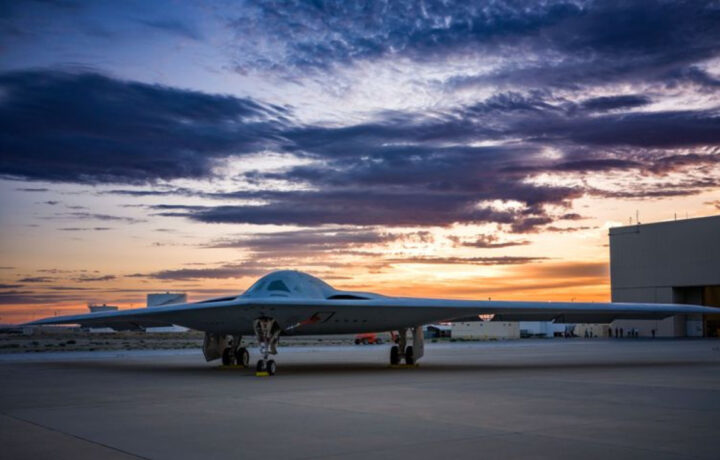The United States Air Force confirmed this week that the Northrop Grumman B-21 Raider has begun taxi tests, which were conducted at Air Force Plant 42 in Palmdale, CA. It is a key step for the stealth bomber as it prepares for its first flight, which is still on track to take place by the end of the year.
Photos of the aircraft conducting ground taxi activities have since circulated on social media.
“Rigorous testing is a critical step in the B-21 flight test program,” an Air Force spokesperson said in a statement. “Extensive testing evaluates systems, components and functionalities. This testing allows us to mitigate risks, optimize design, and enhance operational effectiveness.”
Details Are Slim
Testing of the B-21 Raider, which is being developed as part of the Long Range Strike Bomber (LRS-B) program, has largely been taking place in secret. Key details about the aircraft – including its planform (shape of the wing), range, and payload remained classified.
However, the ground taxi tests come just a month after Northrop Grumman announced it had turned on the Raider’s engines, while in July the electrical power system was switched on for the first time.
The B-21 Raider – The Future Air Force Workhorse
The B-21 is slated to reach initial operational capability in 2025, while it will enter service by 2027. The Air Force intends to purchase at least 100 of the aircraft to replace its Rockwell B-1B Lancer and Northrop Grumman B-2 Spirit bombers in both conventional and nuclear attack missions by 2040. The Raider will operate alongside the Cold War-era Boeing B-52 Stratofortress – which is slated to remain in service until at least the late 2040s.
Development of the B-21 began in 2011, and the Air Force awarded the major development contract for the aircraft in 2015. The Air Force now has at least six B-21s in various stages of production and testing.
“The B-21 Raider is the first strategic bomber in more than three decades,” Secretary of Defense Lloyd J. Austin said during the unveiling ceremony last December. “It is a testament to America’s enduring advantages in ingenuity and innovation. And it’s proof of the Department’s long-term commitment to building advanced capabilities that will fortify America’s ability to deter aggression, today and into the future.”
First Flight Coming Soon
As Air & Space Forces Magazine reported, a taxi test campaign usually follows a pattern where the ground-handling qualities are tested and evaluated at slow and medium speeds before high-speed tests – the latter serving as a direct precursor to the first flight. Moreover, with a large flying wing design, the B-21’s high-speed taxi tests could inadvertently lead to the first flight.
That occurred with the YF-16 in January 1974, when the “eager aircraft” made an unplanned takeoff of its high-speed taxi test.
The Air Force has indicated that there will not be a media event of the first flight, and instead, the B-21 Raider will fly as soon as it is ready. The B-2 Spirit, the B-21’s predecessor, flew just nine months after it was rolled out in 1988. It has already been nearly 11 months since the Raider was unveiled last year.
“While the B-21 first flight will be a data-driven event closely monitored by Northrop Grumman and the U.S. Air Force, key programmatic decisions and strategies are placing the program in a positive position moving forward,” the Falls Church, VA-headquartered Northrop Grumman said in a statement.
Some 8,000 employees of Northrop Grumman and various other defense contractors of all sizes, spread across 40 states, have been secretly building the Air Force’s new stealth bomber.




